University Name: Gender Pay Inequity in Workplace - Report Analysis
VerifiedAdded on 2020/05/28
|21
|4476
|180
Report
AI Summary
This report delves into the pervasive issue of gender pay inequity, a global concern impacting both developed and developing nations, including Australia. It begins by defining gender pay inequity and highlighting its persistent nature, despite increasing female workforce participation. The report explores the various parties involved in perpetuating this inequity and emphasizes the importance of addressing the issue. It then examines the underlying causes of the gender pay gap, including societal mindsets, occupational segregation, and discriminatory practices. Furthermore, the report analyzes the situation in Australia, providing specific data and insights. Finally, it proposes several recommendations for mitigating gender pay inequity at both micro and macro levels, aiming to foster a more equitable and inclusive workplace environment. The report underscores the need for comprehensive strategies to bridge the gender pay gap and promote equal opportunities for all.

Running head: ISSUES IN WORKPLACE
Issues in Workplace
Name of the Student
Name of the University
Author Note
Issues in Workplace
Name of the Student
Name of the University
Author Note
Paraphrase This Document
Need a fresh take? Get an instant paraphrase of this document with our AI Paraphraser
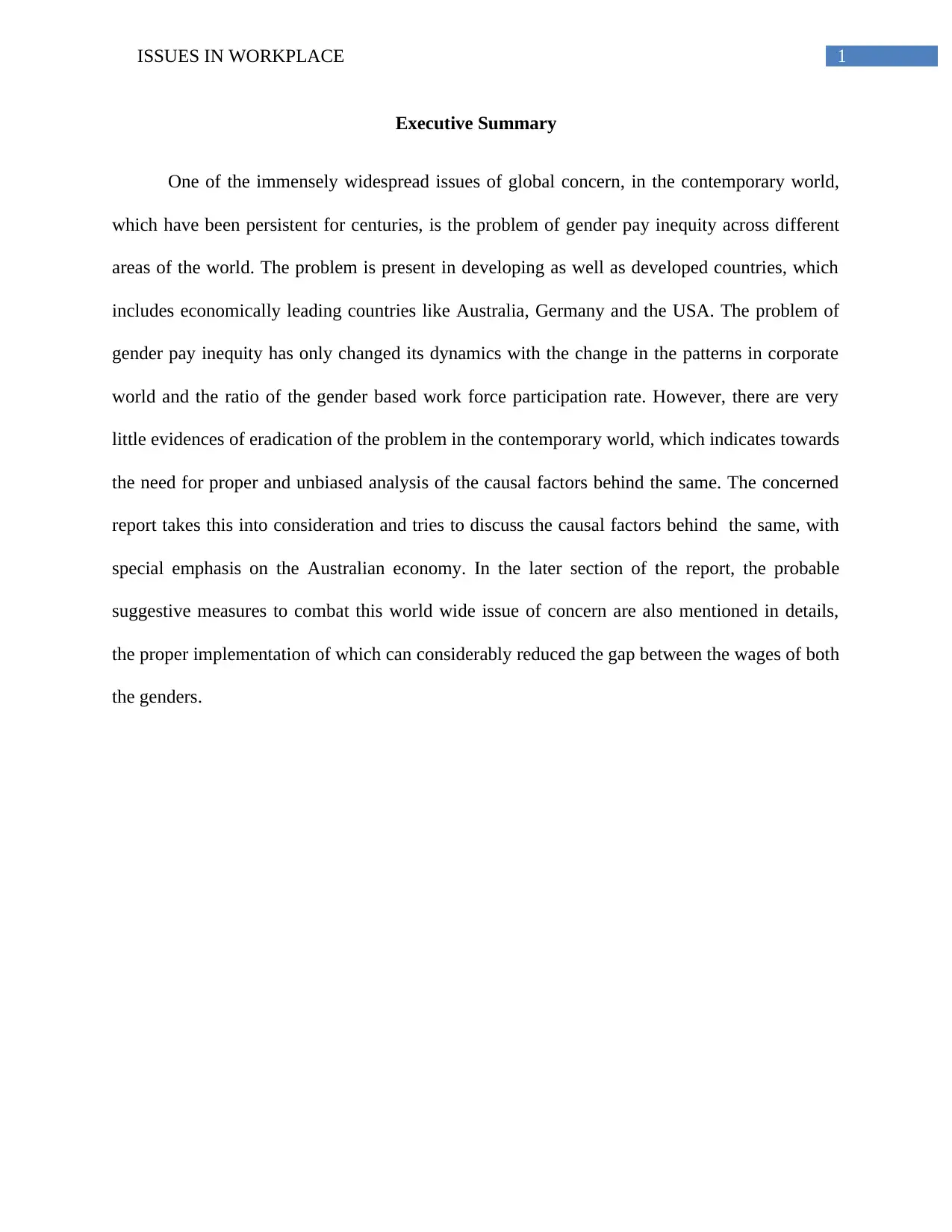
1ISSUES IN WORKPLACE
Executive Summary
One of the immensely widespread issues of global concern, in the contemporary world,
which have been persistent for centuries, is the problem of gender pay inequity across different
areas of the world. The problem is present in developing as well as developed countries, which
includes economically leading countries like Australia, Germany and the USA. The problem of
gender pay inequity has only changed its dynamics with the change in the patterns in corporate
world and the ratio of the gender based work force participation rate. However, there are very
little evidences of eradication of the problem in the contemporary world, which indicates towards
the need for proper and unbiased analysis of the causal factors behind the same. The concerned
report takes this into consideration and tries to discuss the causal factors behind the same, with
special emphasis on the Australian economy. In the later section of the report, the probable
suggestive measures to combat this world wide issue of concern are also mentioned in details,
the proper implementation of which can considerably reduced the gap between the wages of both
the genders.
Executive Summary
One of the immensely widespread issues of global concern, in the contemporary world,
which have been persistent for centuries, is the problem of gender pay inequity across different
areas of the world. The problem is present in developing as well as developed countries, which
includes economically leading countries like Australia, Germany and the USA. The problem of
gender pay inequity has only changed its dynamics with the change in the patterns in corporate
world and the ratio of the gender based work force participation rate. However, there are very
little evidences of eradication of the problem in the contemporary world, which indicates towards
the need for proper and unbiased analysis of the causal factors behind the same. The concerned
report takes this into consideration and tries to discuss the causal factors behind the same, with
special emphasis on the Australian economy. In the later section of the report, the probable
suggestive measures to combat this world wide issue of concern are also mentioned in details,
the proper implementation of which can considerably reduced the gap between the wages of both
the genders.
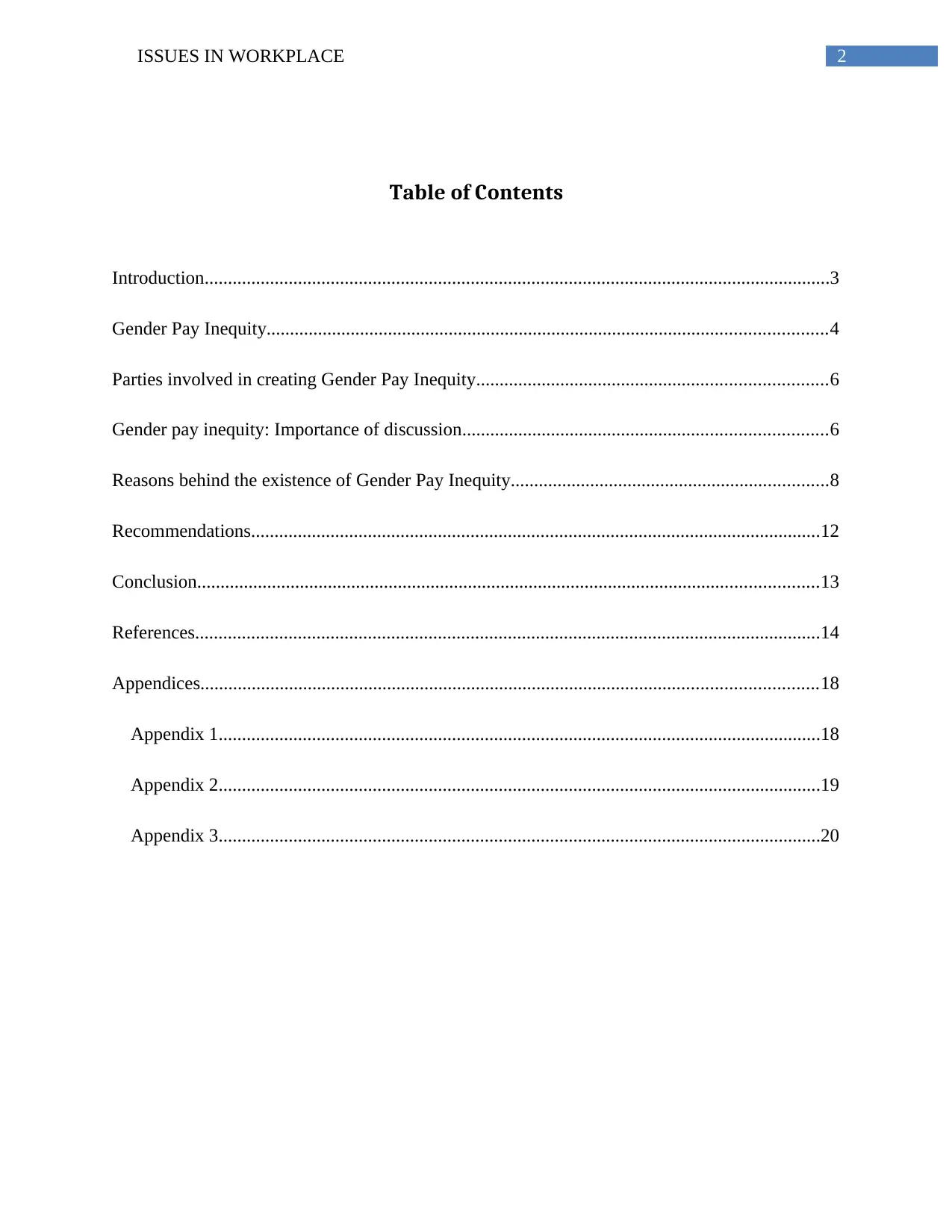
2ISSUES IN WORKPLACE
Table of Contents
Introduction......................................................................................................................................3
Gender Pay Inequity........................................................................................................................4
Parties involved in creating Gender Pay Inequity...........................................................................6
Gender pay inequity: Importance of discussion..............................................................................6
Reasons behind the existence of Gender Pay Inequity....................................................................8
Recommendations..........................................................................................................................12
Conclusion.....................................................................................................................................13
References......................................................................................................................................14
Appendices....................................................................................................................................18
Appendix 1.................................................................................................................................18
Appendix 2.................................................................................................................................19
Appendix 3.................................................................................................................................20
Table of Contents
Introduction......................................................................................................................................3
Gender Pay Inequity........................................................................................................................4
Parties involved in creating Gender Pay Inequity...........................................................................6
Gender pay inequity: Importance of discussion..............................................................................6
Reasons behind the existence of Gender Pay Inequity....................................................................8
Recommendations..........................................................................................................................12
Conclusion.....................................................................................................................................13
References......................................................................................................................................14
Appendices....................................................................................................................................18
Appendix 1.................................................................................................................................18
Appendix 2.................................................................................................................................19
Appendix 3.................................................................................................................................20
⊘ This is a preview!⊘
Do you want full access?
Subscribe today to unlock all pages.

Trusted by 1+ million students worldwide
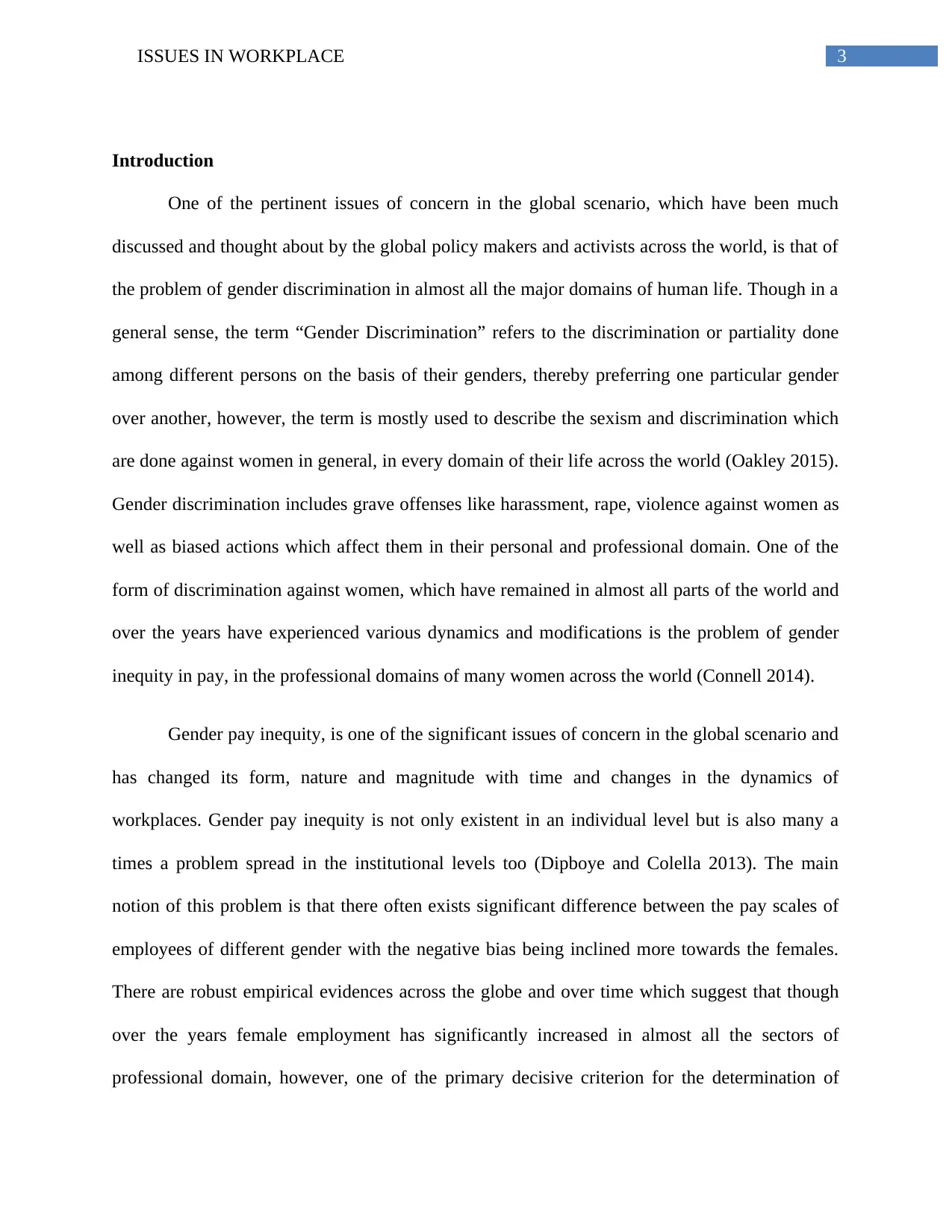
3ISSUES IN WORKPLACE
Introduction
One of the pertinent issues of concern in the global scenario, which have been much
discussed and thought about by the global policy makers and activists across the world, is that of
the problem of gender discrimination in almost all the major domains of human life. Though in a
general sense, the term “Gender Discrimination” refers to the discrimination or partiality done
among different persons on the basis of their genders, thereby preferring one particular gender
over another, however, the term is mostly used to describe the sexism and discrimination which
are done against women in general, in every domain of their life across the world (Oakley 2015).
Gender discrimination includes grave offenses like harassment, rape, violence against women as
well as biased actions which affect them in their personal and professional domain. One of the
form of discrimination against women, which have remained in almost all parts of the world and
over the years have experienced various dynamics and modifications is the problem of gender
inequity in pay, in the professional domains of many women across the world (Connell 2014).
Gender pay inequity, is one of the significant issues of concern in the global scenario and
has changed its form, nature and magnitude with time and changes in the dynamics of
workplaces. Gender pay inequity is not only existent in an individual level but is also many a
times a problem spread in the institutional levels too (Dipboye and Colella 2013). The main
notion of this problem is that there often exists significant difference between the pay scales of
employees of different gender with the negative bias being inclined more towards the females.
There are robust empirical evidences across the globe and over time which suggest that though
over the years female employment has significantly increased in almost all the sectors of
professional domain, however, one of the primary decisive criterion for the determination of
Introduction
One of the pertinent issues of concern in the global scenario, which have been much
discussed and thought about by the global policy makers and activists across the world, is that of
the problem of gender discrimination in almost all the major domains of human life. Though in a
general sense, the term “Gender Discrimination” refers to the discrimination or partiality done
among different persons on the basis of their genders, thereby preferring one particular gender
over another, however, the term is mostly used to describe the sexism and discrimination which
are done against women in general, in every domain of their life across the world (Oakley 2015).
Gender discrimination includes grave offenses like harassment, rape, violence against women as
well as biased actions which affect them in their personal and professional domain. One of the
form of discrimination against women, which have remained in almost all parts of the world and
over the years have experienced various dynamics and modifications is the problem of gender
inequity in pay, in the professional domains of many women across the world (Connell 2014).
Gender pay inequity, is one of the significant issues of concern in the global scenario and
has changed its form, nature and magnitude with time and changes in the dynamics of
workplaces. Gender pay inequity is not only existent in an individual level but is also many a
times a problem spread in the institutional levels too (Dipboye and Colella 2013). The main
notion of this problem is that there often exists significant difference between the pay scales of
employees of different gender with the negative bias being inclined more towards the females.
There are robust empirical evidences across the globe and over time which suggest that though
over the years female employment has significantly increased in almost all the sectors of
professional domain, however, one of the primary decisive criterion for the determination of
Paraphrase This Document
Need a fresh take? Get an instant paraphrase of this document with our AI Paraphraser

4ISSUES IN WORKPLACE
professional positions of people in their workplace has been their gender (Nadler and Stockdale
2012).
It has been often observed that women employees, including the full time as well as part
time workers, in many sectors across different parts of the world earn significantly lower than
their male counterparts. Keeping this into consideration, the concerned report focuses on the
phenomenon of inequity in payment based on gender which is prevalent in the global framework,
analyzing the possible reasons behind the existence of the same, with special emphasis on the
economy of Australia (Heilman 2012). The latter section of the report tries to suggest several
rectifications and steps which can be implemented in the micro as well as macro level to combat
the concerned problem.
Gender Pay Inequity
The inequity in pay based on gender, being one of the most prominent forms of economic
inequalities existing in the contemporary periods, is in the broad sense the discrimination
between men and women workers in terms of their earnings and is usually computed as a ratio
earnings of women to that of their men counterparts, expressed in the form of a percentage. In
the earlier periods, the overall labor force participation rate of women in almost all the sectors of
economy had been significantly low as compared to the men (Lips 2013). However, this scenario
has changed considerably in the last few decades, with more and more women participating in
the employment sector, with a general increase in their education and skill level, in the global
scenario.
As can be seen from the figure showing the changes in the labor force participation over
the years (Refer to Appendix 1), the share of females in the labor force (Seasonally Adjusted
professional positions of people in their workplace has been their gender (Nadler and Stockdale
2012).
It has been often observed that women employees, including the full time as well as part
time workers, in many sectors across different parts of the world earn significantly lower than
their male counterparts. Keeping this into consideration, the concerned report focuses on the
phenomenon of inequity in payment based on gender which is prevalent in the global framework,
analyzing the possible reasons behind the existence of the same, with special emphasis on the
economy of Australia (Heilman 2012). The latter section of the report tries to suggest several
rectifications and steps which can be implemented in the micro as well as macro level to combat
the concerned problem.
Gender Pay Inequity
The inequity in pay based on gender, being one of the most prominent forms of economic
inequalities existing in the contemporary periods, is in the broad sense the discrimination
between men and women workers in terms of their earnings and is usually computed as a ratio
earnings of women to that of their men counterparts, expressed in the form of a percentage. In
the earlier periods, the overall labor force participation rate of women in almost all the sectors of
economy had been significantly low as compared to the men (Lips 2013). However, this scenario
has changed considerably in the last few decades, with more and more women participating in
the employment sector, with a general increase in their education and skill level, in the global
scenario.
As can be seen from the figure showing the changes in the labor force participation over
the years (Refer to Appendix 1), the share of females in the labor force (Seasonally Adjusted
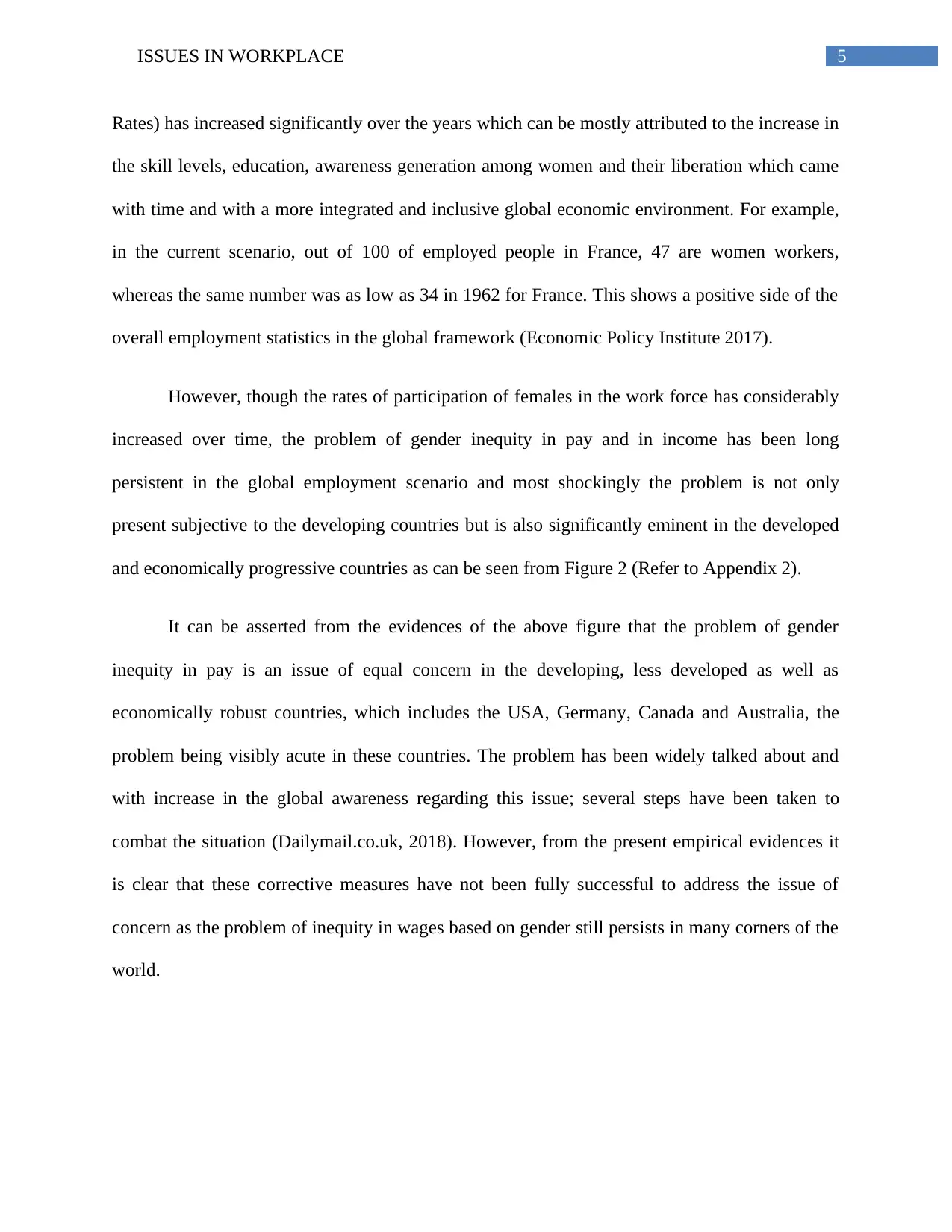
5ISSUES IN WORKPLACE
Rates) has increased significantly over the years which can be mostly attributed to the increase in
the skill levels, education, awareness generation among women and their liberation which came
with time and with a more integrated and inclusive global economic environment. For example,
in the current scenario, out of 100 of employed people in France, 47 are women workers,
whereas the same number was as low as 34 in 1962 for France. This shows a positive side of the
overall employment statistics in the global framework (Economic Policy Institute 2017).
However, though the rates of participation of females in the work force has considerably
increased over time, the problem of gender inequity in pay and in income has been long
persistent in the global employment scenario and most shockingly the problem is not only
present subjective to the developing countries but is also significantly eminent in the developed
and economically progressive countries as can be seen from Figure 2 (Refer to Appendix 2).
It can be asserted from the evidences of the above figure that the problem of gender
inequity in pay is an issue of equal concern in the developing, less developed as well as
economically robust countries, which includes the USA, Germany, Canada and Australia, the
problem being visibly acute in these countries. The problem has been widely talked about and
with increase in the global awareness regarding this issue; several steps have been taken to
combat the situation (Dailymail.co.uk, 2018). However, from the present empirical evidences it
is clear that these corrective measures have not been fully successful to address the issue of
concern as the problem of inequity in wages based on gender still persists in many corners of the
world.
Rates) has increased significantly over the years which can be mostly attributed to the increase in
the skill levels, education, awareness generation among women and their liberation which came
with time and with a more integrated and inclusive global economic environment. For example,
in the current scenario, out of 100 of employed people in France, 47 are women workers,
whereas the same number was as low as 34 in 1962 for France. This shows a positive side of the
overall employment statistics in the global framework (Economic Policy Institute 2017).
However, though the rates of participation of females in the work force has considerably
increased over time, the problem of gender inequity in pay and in income has been long
persistent in the global employment scenario and most shockingly the problem is not only
present subjective to the developing countries but is also significantly eminent in the developed
and economically progressive countries as can be seen from Figure 2 (Refer to Appendix 2).
It can be asserted from the evidences of the above figure that the problem of gender
inequity in pay is an issue of equal concern in the developing, less developed as well as
economically robust countries, which includes the USA, Germany, Canada and Australia, the
problem being visibly acute in these countries. The problem has been widely talked about and
with increase in the global awareness regarding this issue; several steps have been taken to
combat the situation (Dailymail.co.uk, 2018). However, from the present empirical evidences it
is clear that these corrective measures have not been fully successful to address the issue of
concern as the problem of inequity in wages based on gender still persists in many corners of the
world.
⊘ This is a preview!⊘
Do you want full access?
Subscribe today to unlock all pages.

Trusted by 1+ million students worldwide
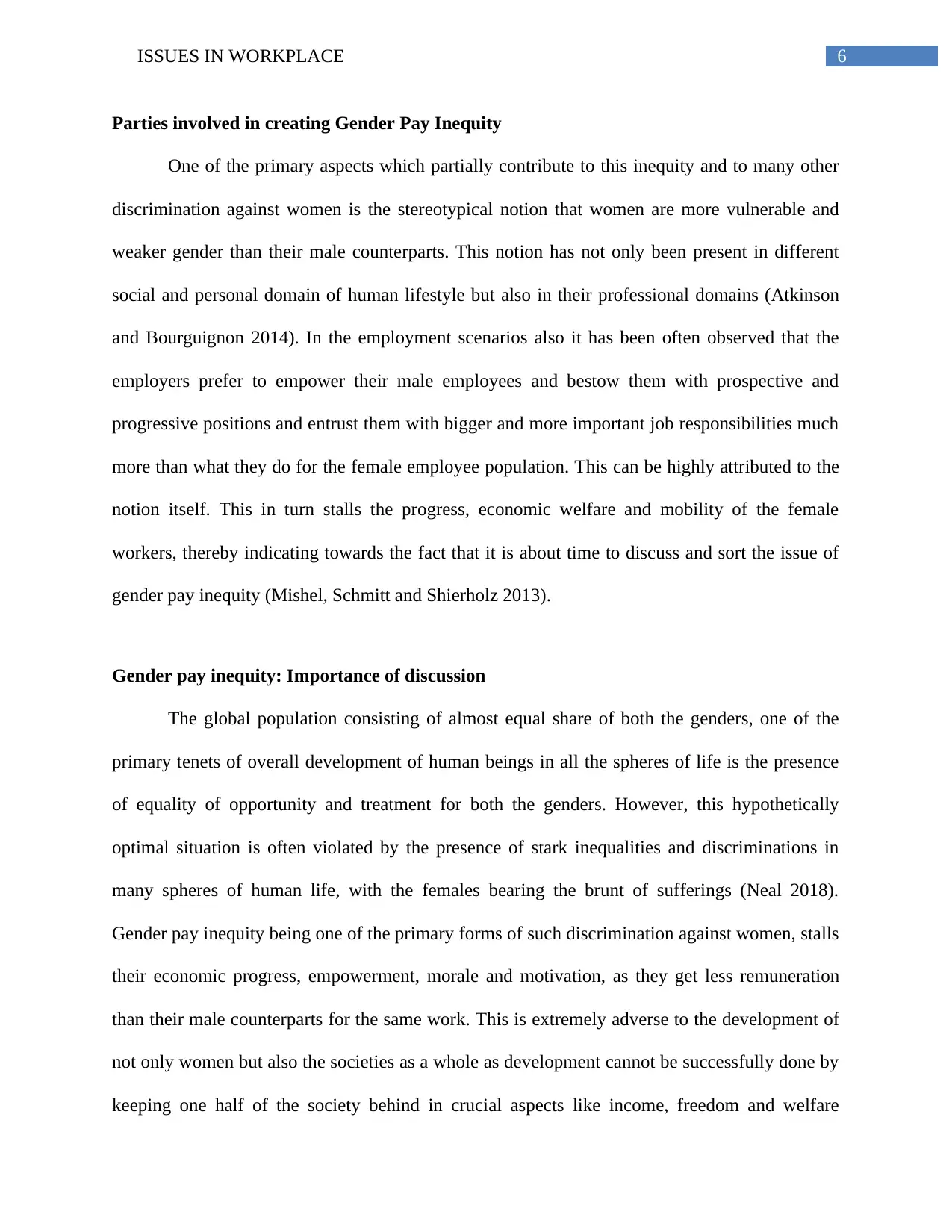
6ISSUES IN WORKPLACE
Parties involved in creating Gender Pay Inequity
One of the primary aspects which partially contribute to this inequity and to many other
discrimination against women is the stereotypical notion that women are more vulnerable and
weaker gender than their male counterparts. This notion has not only been present in different
social and personal domain of human lifestyle but also in their professional domains (Atkinson
and Bourguignon 2014). In the employment scenarios also it has been often observed that the
employers prefer to empower their male employees and bestow them with prospective and
progressive positions and entrust them with bigger and more important job responsibilities much
more than what they do for the female employee population. This can be highly attributed to the
notion itself. This in turn stalls the progress, economic welfare and mobility of the female
workers, thereby indicating towards the fact that it is about time to discuss and sort the issue of
gender pay inequity (Mishel, Schmitt and Shierholz 2013).
Gender pay inequity: Importance of discussion
The global population consisting of almost equal share of both the genders, one of the
primary tenets of overall development of human beings in all the spheres of life is the presence
of equality of opportunity and treatment for both the genders. However, this hypothetically
optimal situation is often violated by the presence of stark inequalities and discriminations in
many spheres of human life, with the females bearing the brunt of sufferings (Neal 2018).
Gender pay inequity being one of the primary forms of such discrimination against women, stalls
their economic progress, empowerment, morale and motivation, as they get less remuneration
than their male counterparts for the same work. This is extremely adverse to the development of
not only women but also the societies as a whole as development cannot be successfully done by
keeping one half of the society behind in crucial aspects like income, freedom and welfare
Parties involved in creating Gender Pay Inequity
One of the primary aspects which partially contribute to this inequity and to many other
discrimination against women is the stereotypical notion that women are more vulnerable and
weaker gender than their male counterparts. This notion has not only been present in different
social and personal domain of human lifestyle but also in their professional domains (Atkinson
and Bourguignon 2014). In the employment scenarios also it has been often observed that the
employers prefer to empower their male employees and bestow them with prospective and
progressive positions and entrust them with bigger and more important job responsibilities much
more than what they do for the female employee population. This can be highly attributed to the
notion itself. This in turn stalls the progress, economic welfare and mobility of the female
workers, thereby indicating towards the fact that it is about time to discuss and sort the issue of
gender pay inequity (Mishel, Schmitt and Shierholz 2013).
Gender pay inequity: Importance of discussion
The global population consisting of almost equal share of both the genders, one of the
primary tenets of overall development of human beings in all the spheres of life is the presence
of equality of opportunity and treatment for both the genders. However, this hypothetically
optimal situation is often violated by the presence of stark inequalities and discriminations in
many spheres of human life, with the females bearing the brunt of sufferings (Neal 2018).
Gender pay inequity being one of the primary forms of such discrimination against women, stalls
their economic progress, empowerment, morale and motivation, as they get less remuneration
than their male counterparts for the same work. This is extremely adverse to the development of
not only women but also the societies as a whole as development cannot be successfully done by
keeping one half of the society behind in crucial aspects like income, freedom and welfare
Paraphrase This Document
Need a fresh take? Get an instant paraphrase of this document with our AI Paraphraser
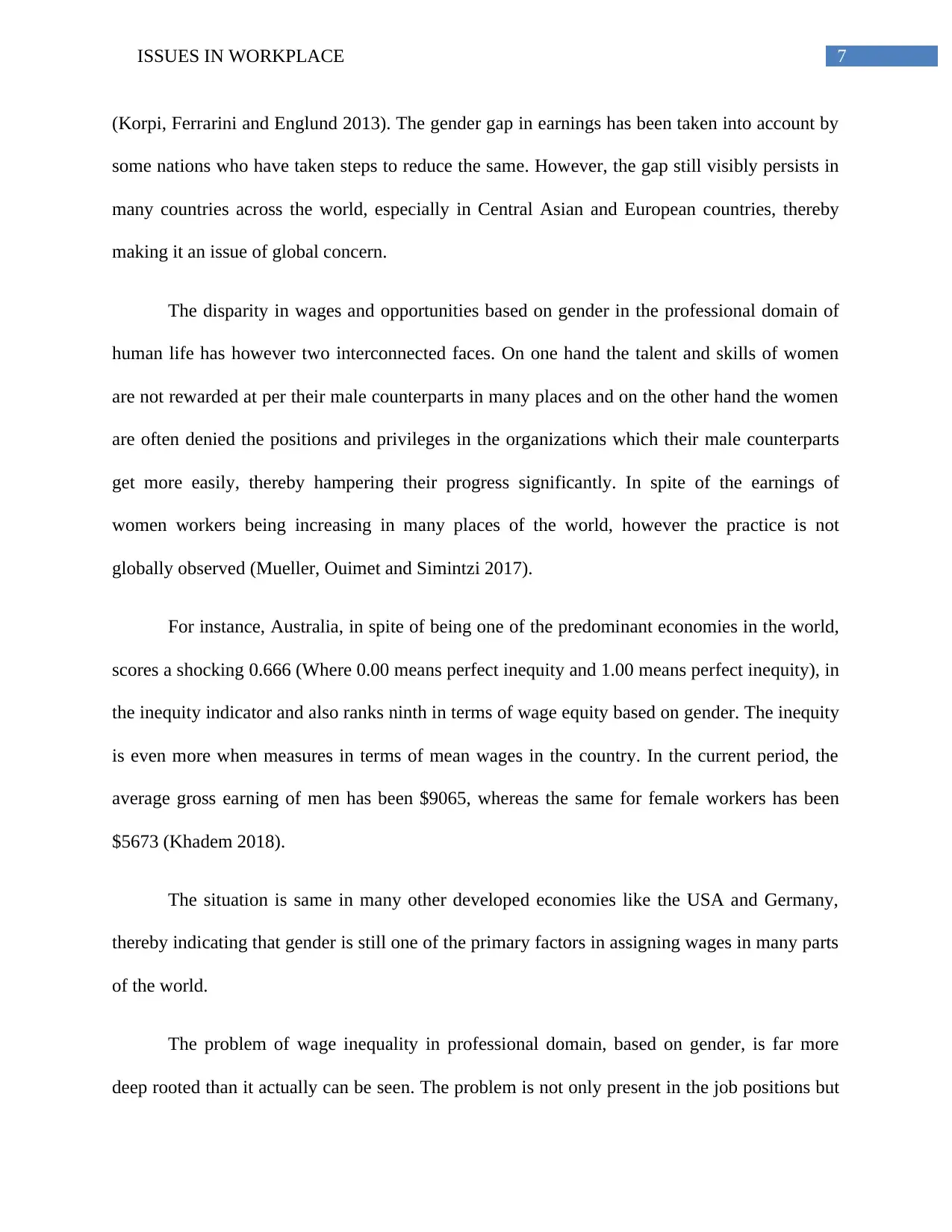
7ISSUES IN WORKPLACE
(Korpi, Ferrarini and Englund 2013). The gender gap in earnings has been taken into account by
some nations who have taken steps to reduce the same. However, the gap still visibly persists in
many countries across the world, especially in Central Asian and European countries, thereby
making it an issue of global concern.
The disparity in wages and opportunities based on gender in the professional domain of
human life has however two interconnected faces. On one hand the talent and skills of women
are not rewarded at per their male counterparts in many places and on the other hand the women
are often denied the positions and privileges in the organizations which their male counterparts
get more easily, thereby hampering their progress significantly. In spite of the earnings of
women workers being increasing in many places of the world, however the practice is not
globally observed (Mueller, Ouimet and Simintzi 2017).
For instance, Australia, in spite of being one of the predominant economies in the world,
scores a shocking 0.666 (Where 0.00 means perfect inequity and 1.00 means perfect inequity), in
the inequity indicator and also ranks ninth in terms of wage equity based on gender. The inequity
is even more when measures in terms of mean wages in the country. In the current period, the
average gross earning of men has been $9065, whereas the same for female workers has been
$5673 (Khadem 2018).
The situation is same in many other developed economies like the USA and Germany,
thereby indicating that gender is still one of the primary factors in assigning wages in many parts
of the world.
The problem of wage inequality in professional domain, based on gender, is far more
deep rooted than it actually can be seen. The problem is not only present in the job positions but
(Korpi, Ferrarini and Englund 2013). The gender gap in earnings has been taken into account by
some nations who have taken steps to reduce the same. However, the gap still visibly persists in
many countries across the world, especially in Central Asian and European countries, thereby
making it an issue of global concern.
The disparity in wages and opportunities based on gender in the professional domain of
human life has however two interconnected faces. On one hand the talent and skills of women
are not rewarded at per their male counterparts in many places and on the other hand the women
are often denied the positions and privileges in the organizations which their male counterparts
get more easily, thereby hampering their progress significantly. In spite of the earnings of
women workers being increasing in many places of the world, however the practice is not
globally observed (Mueller, Ouimet and Simintzi 2017).
For instance, Australia, in spite of being one of the predominant economies in the world,
scores a shocking 0.666 (Where 0.00 means perfect inequity and 1.00 means perfect inequity), in
the inequity indicator and also ranks ninth in terms of wage equity based on gender. The inequity
is even more when measures in terms of mean wages in the country. In the current period, the
average gross earning of men has been $9065, whereas the same for female workers has been
$5673 (Khadem 2018).
The situation is same in many other developed economies like the USA and Germany,
thereby indicating that gender is still one of the primary factors in assigning wages in many parts
of the world.
The problem of wage inequality in professional domain, based on gender, is far more
deep rooted than it actually can be seen. The problem is not only present in the job positions but
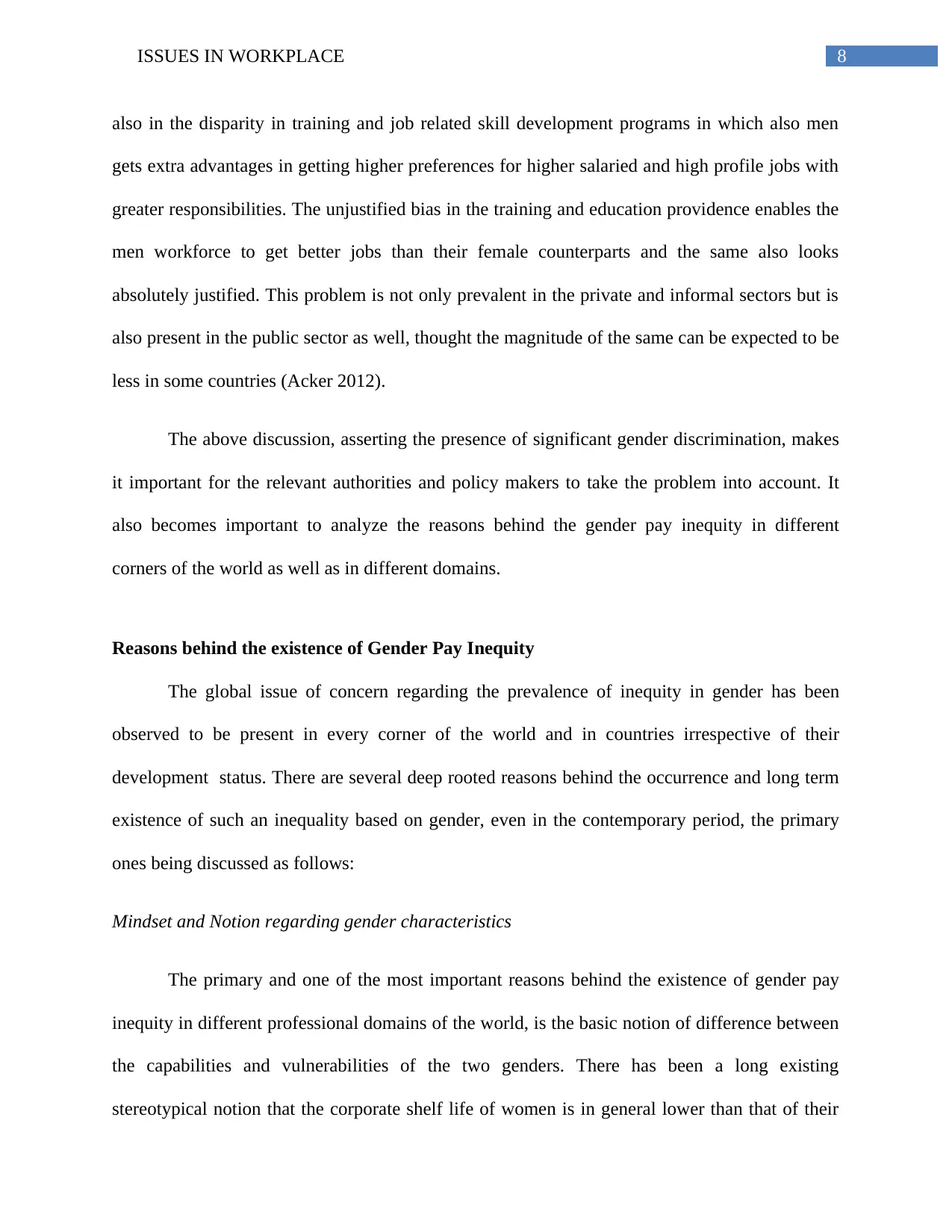
8ISSUES IN WORKPLACE
also in the disparity in training and job related skill development programs in which also men
gets extra advantages in getting higher preferences for higher salaried and high profile jobs with
greater responsibilities. The unjustified bias in the training and education providence enables the
men workforce to get better jobs than their female counterparts and the same also looks
absolutely justified. This problem is not only prevalent in the private and informal sectors but is
also present in the public sector as well, thought the magnitude of the same can be expected to be
less in some countries (Acker 2012).
The above discussion, asserting the presence of significant gender discrimination, makes
it important for the relevant authorities and policy makers to take the problem into account. It
also becomes important to analyze the reasons behind the gender pay inequity in different
corners of the world as well as in different domains.
Reasons behind the existence of Gender Pay Inequity
The global issue of concern regarding the prevalence of inequity in gender has been
observed to be present in every corner of the world and in countries irrespective of their
development status. There are several deep rooted reasons behind the occurrence and long term
existence of such an inequality based on gender, even in the contemporary period, the primary
ones being discussed as follows:
Mindset and Notion regarding gender characteristics
The primary and one of the most important reasons behind the existence of gender pay
inequity in different professional domains of the world, is the basic notion of difference between
the capabilities and vulnerabilities of the two genders. There has been a long existing
stereotypical notion that the corporate shelf life of women is in general lower than that of their
also in the disparity in training and job related skill development programs in which also men
gets extra advantages in getting higher preferences for higher salaried and high profile jobs with
greater responsibilities. The unjustified bias in the training and education providence enables the
men workforce to get better jobs than their female counterparts and the same also looks
absolutely justified. This problem is not only prevalent in the private and informal sectors but is
also present in the public sector as well, thought the magnitude of the same can be expected to be
less in some countries (Acker 2012).
The above discussion, asserting the presence of significant gender discrimination, makes
it important for the relevant authorities and policy makers to take the problem into account. It
also becomes important to analyze the reasons behind the gender pay inequity in different
corners of the world as well as in different domains.
Reasons behind the existence of Gender Pay Inequity
The global issue of concern regarding the prevalence of inequity in gender has been
observed to be present in every corner of the world and in countries irrespective of their
development status. There are several deep rooted reasons behind the occurrence and long term
existence of such an inequality based on gender, even in the contemporary period, the primary
ones being discussed as follows:
Mindset and Notion regarding gender characteristics
The primary and one of the most important reasons behind the existence of gender pay
inequity in different professional domains of the world, is the basic notion of difference between
the capabilities and vulnerabilities of the two genders. There has been a long existing
stereotypical notion that the corporate shelf life of women is in general lower than that of their
⊘ This is a preview!⊘
Do you want full access?
Subscribe today to unlock all pages.

Trusted by 1+ million students worldwide
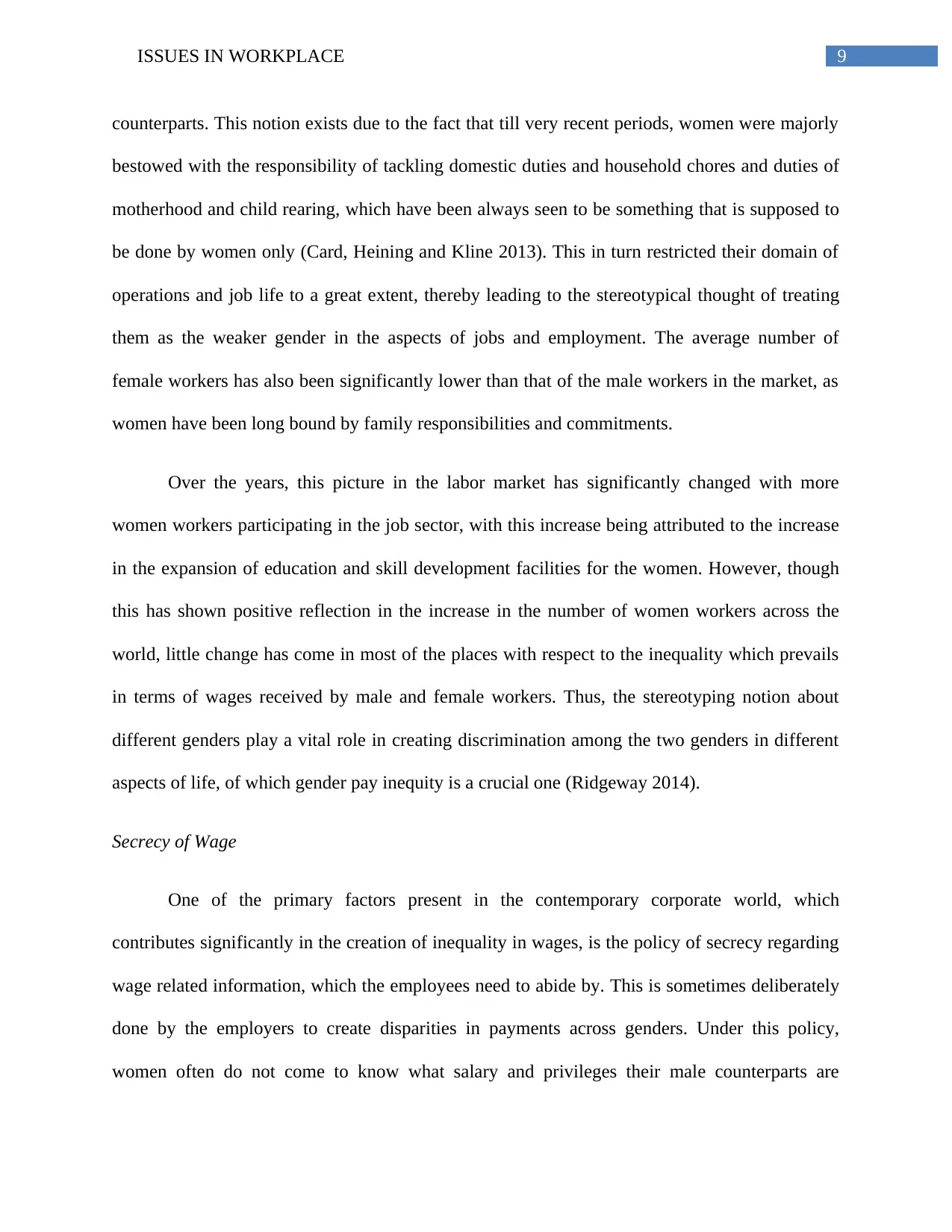
9ISSUES IN WORKPLACE
counterparts. This notion exists due to the fact that till very recent periods, women were majorly
bestowed with the responsibility of tackling domestic duties and household chores and duties of
motherhood and child rearing, which have been always seen to be something that is supposed to
be done by women only (Card, Heining and Kline 2013). This in turn restricted their domain of
operations and job life to a great extent, thereby leading to the stereotypical thought of treating
them as the weaker gender in the aspects of jobs and employment. The average number of
female workers has also been significantly lower than that of the male workers in the market, as
women have been long bound by family responsibilities and commitments.
Over the years, this picture in the labor market has significantly changed with more
women workers participating in the job sector, with this increase being attributed to the increase
in the expansion of education and skill development facilities for the women. However, though
this has shown positive reflection in the increase in the number of women workers across the
world, little change has come in most of the places with respect to the inequality which prevails
in terms of wages received by male and female workers. Thus, the stereotyping notion about
different genders play a vital role in creating discrimination among the two genders in different
aspects of life, of which gender pay inequity is a crucial one (Ridgeway 2014).
Secrecy of Wage
One of the primary factors present in the contemporary corporate world, which
contributes significantly in the creation of inequality in wages, is the policy of secrecy regarding
wage related information, which the employees need to abide by. This is sometimes deliberately
done by the employers to create disparities in payments across genders. Under this policy,
women often do not come to know what salary and privileges their male counterparts are
counterparts. This notion exists due to the fact that till very recent periods, women were majorly
bestowed with the responsibility of tackling domestic duties and household chores and duties of
motherhood and child rearing, which have been always seen to be something that is supposed to
be done by women only (Card, Heining and Kline 2013). This in turn restricted their domain of
operations and job life to a great extent, thereby leading to the stereotypical thought of treating
them as the weaker gender in the aspects of jobs and employment. The average number of
female workers has also been significantly lower than that of the male workers in the market, as
women have been long bound by family responsibilities and commitments.
Over the years, this picture in the labor market has significantly changed with more
women workers participating in the job sector, with this increase being attributed to the increase
in the expansion of education and skill development facilities for the women. However, though
this has shown positive reflection in the increase in the number of women workers across the
world, little change has come in most of the places with respect to the inequality which prevails
in terms of wages received by male and female workers. Thus, the stereotyping notion about
different genders play a vital role in creating discrimination among the two genders in different
aspects of life, of which gender pay inequity is a crucial one (Ridgeway 2014).
Secrecy of Wage
One of the primary factors present in the contemporary corporate world, which
contributes significantly in the creation of inequality in wages, is the policy of secrecy regarding
wage related information, which the employees need to abide by. This is sometimes deliberately
done by the employers to create disparities in payments across genders. Under this policy,
women often do not come to know what salary and privileges their male counterparts are
Paraphrase This Document
Need a fresh take? Get an instant paraphrase of this document with our AI Paraphraser
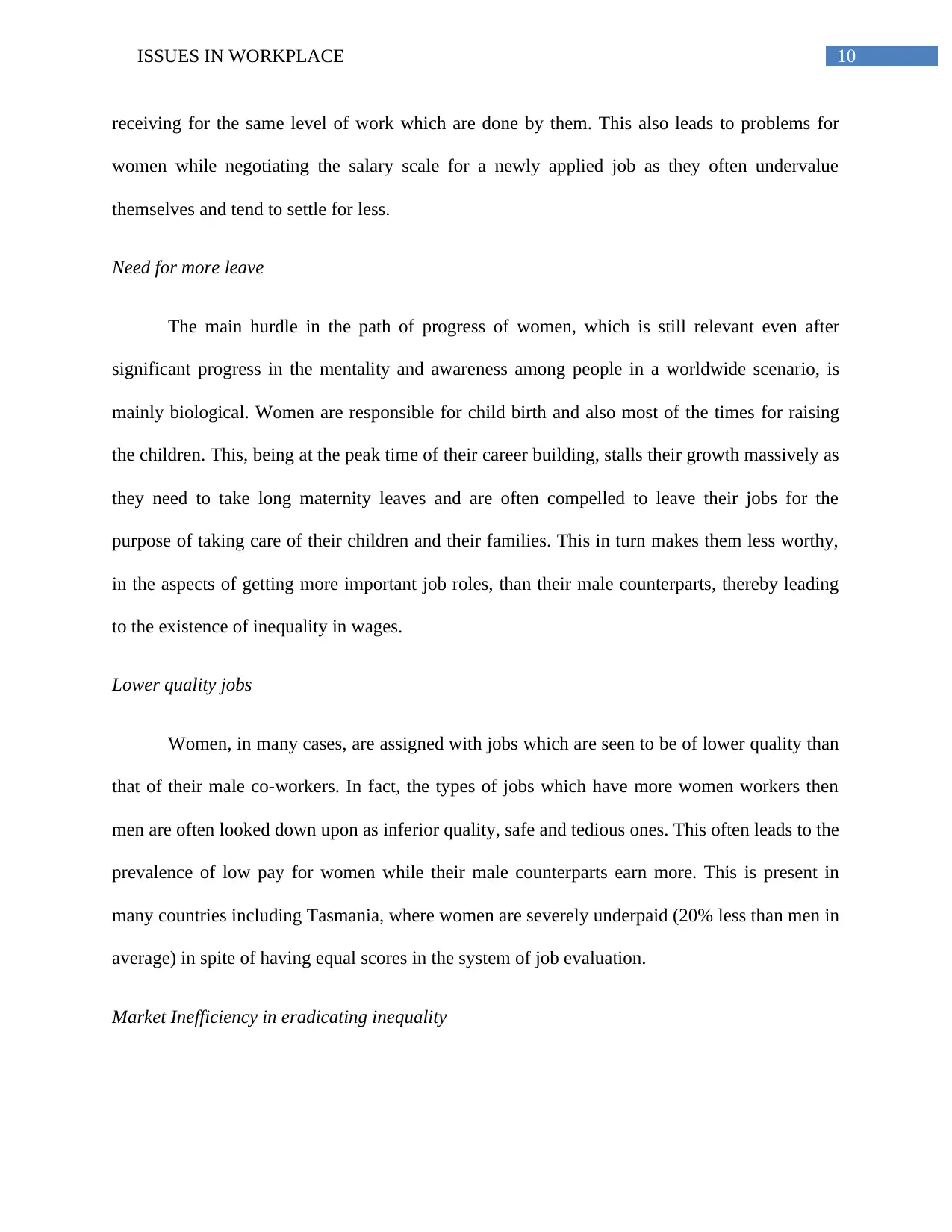
10ISSUES IN WORKPLACE
receiving for the same level of work which are done by them. This also leads to problems for
women while negotiating the salary scale for a newly applied job as they often undervalue
themselves and tend to settle for less.
Need for more leave
The main hurdle in the path of progress of women, which is still relevant even after
significant progress in the mentality and awareness among people in a worldwide scenario, is
mainly biological. Women are responsible for child birth and also most of the times for raising
the children. This, being at the peak time of their career building, stalls their growth massively as
they need to take long maternity leaves and are often compelled to leave their jobs for the
purpose of taking care of their children and their families. This in turn makes them less worthy,
in the aspects of getting more important job roles, than their male counterparts, thereby leading
to the existence of inequality in wages.
Lower quality jobs
Women, in many cases, are assigned with jobs which are seen to be of lower quality than
that of their male co-workers. In fact, the types of jobs which have more women workers then
men are often looked down upon as inferior quality, safe and tedious ones. This often leads to the
prevalence of low pay for women while their male counterparts earn more. This is present in
many countries including Tasmania, where women are severely underpaid (20% less than men in
average) in spite of having equal scores in the system of job evaluation.
Market Inefficiency in eradicating inequality
receiving for the same level of work which are done by them. This also leads to problems for
women while negotiating the salary scale for a newly applied job as they often undervalue
themselves and tend to settle for less.
Need for more leave
The main hurdle in the path of progress of women, which is still relevant even after
significant progress in the mentality and awareness among people in a worldwide scenario, is
mainly biological. Women are responsible for child birth and also most of the times for raising
the children. This, being at the peak time of their career building, stalls their growth massively as
they need to take long maternity leaves and are often compelled to leave their jobs for the
purpose of taking care of their children and their families. This in turn makes them less worthy,
in the aspects of getting more important job roles, than their male counterparts, thereby leading
to the existence of inequality in wages.
Lower quality jobs
Women, in many cases, are assigned with jobs which are seen to be of lower quality than
that of their male co-workers. In fact, the types of jobs which have more women workers then
men are often looked down upon as inferior quality, safe and tedious ones. This often leads to the
prevalence of low pay for women while their male counterparts earn more. This is present in
many countries including Tasmania, where women are severely underpaid (20% less than men in
average) in spite of having equal scores in the system of job evaluation.
Market Inefficiency in eradicating inequality
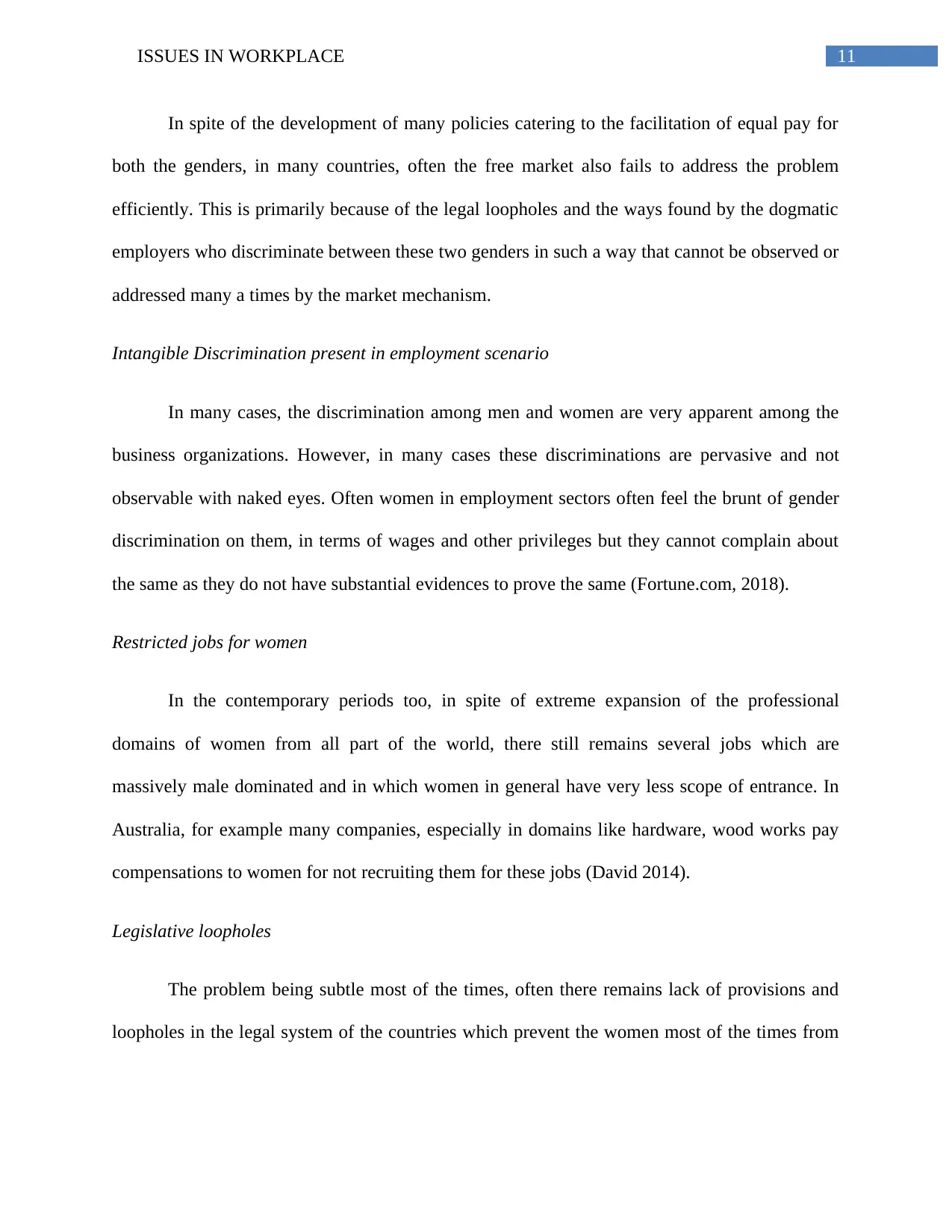
11ISSUES IN WORKPLACE
In spite of the development of many policies catering to the facilitation of equal pay for
both the genders, in many countries, often the free market also fails to address the problem
efficiently. This is primarily because of the legal loopholes and the ways found by the dogmatic
employers who discriminate between these two genders in such a way that cannot be observed or
addressed many a times by the market mechanism.
Intangible Discrimination present in employment scenario
In many cases, the discrimination among men and women are very apparent among the
business organizations. However, in many cases these discriminations are pervasive and not
observable with naked eyes. Often women in employment sectors often feel the brunt of gender
discrimination on them, in terms of wages and other privileges but they cannot complain about
the same as they do not have substantial evidences to prove the same (Fortune.com, 2018).
Restricted jobs for women
In the contemporary periods too, in spite of extreme expansion of the professional
domains of women from all part of the world, there still remains several jobs which are
massively male dominated and in which women in general have very less scope of entrance. In
Australia, for example many companies, especially in domains like hardware, wood works pay
compensations to women for not recruiting them for these jobs (David 2014).
Legislative loopholes
The problem being subtle most of the times, often there remains lack of provisions and
loopholes in the legal system of the countries which prevent the women most of the times from
In spite of the development of many policies catering to the facilitation of equal pay for
both the genders, in many countries, often the free market also fails to address the problem
efficiently. This is primarily because of the legal loopholes and the ways found by the dogmatic
employers who discriminate between these two genders in such a way that cannot be observed or
addressed many a times by the market mechanism.
Intangible Discrimination present in employment scenario
In many cases, the discrimination among men and women are very apparent among the
business organizations. However, in many cases these discriminations are pervasive and not
observable with naked eyes. Often women in employment sectors often feel the brunt of gender
discrimination on them, in terms of wages and other privileges but they cannot complain about
the same as they do not have substantial evidences to prove the same (Fortune.com, 2018).
Restricted jobs for women
In the contemporary periods too, in spite of extreme expansion of the professional
domains of women from all part of the world, there still remains several jobs which are
massively male dominated and in which women in general have very less scope of entrance. In
Australia, for example many companies, especially in domains like hardware, wood works pay
compensations to women for not recruiting them for these jobs (David 2014).
Legislative loopholes
The problem being subtle most of the times, often there remains lack of provisions and
loopholes in the legal system of the countries which prevent the women most of the times from
⊘ This is a preview!⊘
Do you want full access?
Subscribe today to unlock all pages.

Trusted by 1+ million students worldwide
1 out of 21
Related Documents
Your All-in-One AI-Powered Toolkit for Academic Success.
+13062052269
info@desklib.com
Available 24*7 on WhatsApp / Email
![[object Object]](/_next/static/media/star-bottom.7253800d.svg)
Unlock your academic potential
Copyright © 2020–2026 A2Z Services. All Rights Reserved. Developed and managed by ZUCOL.





